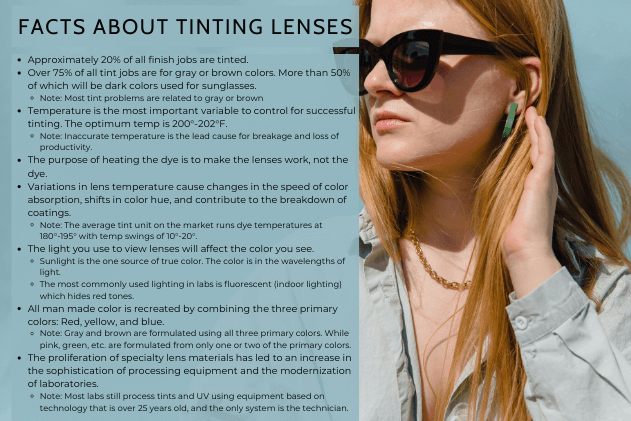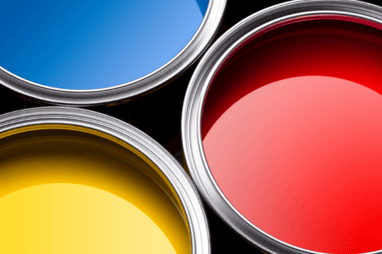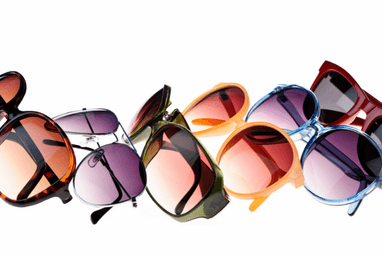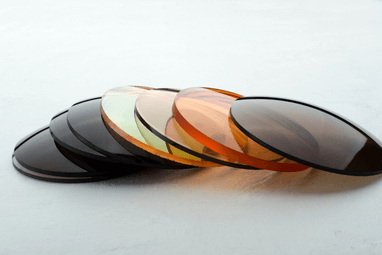Tinting Lenses - Part 1

Chances are that if you have an in-house finishing lab then you tint your own lenses. In this 2 part series on tinting lenses, we are going to go over some of the basics of tinting while digging into the science behind achieving good results.
PART 1 - The Science of Tinting Lenses
Contrary to what many believe - TINTING LENSES IS A SCIENCE NOT AN ART! Yes, I just said that and I am sure that I will hear back from a few people with an argument. We will get back to this later but for now, let's cover some facts:

There are four sciences that affect tinting: Color, lens physics, dye chemistry, and production ergonomics
THE SCIENCE OF COLOR:
Color is defined as the relationship of three elements:
- Light, the source of color
- The Object/Material, how it responds to light
- And the Eye, which perceives the color.
Light is the only source of color, objects are merely reflectors, absorbers or transmitters (lenses) of one or more of the colors of light.
Sunlight is the only pure light source. Light is white, while the absence of light is black. Light broken into (or transmitted as) a special wavelength is perceived as color.
Manmade light has a different spectral distribution than sunlight and therefore, will create different colors; i.e. the color of a tinted lens will change when viewed under different light sources.
Objects reflect or transmit some or all of the colors of light back to our eye.

The intensity and distribution of the various wavelengths of the light transmitted to our eyes determines the color and brightness (density) that we perceive.
All pigments (dyes, paints, stains, etc.) achieve their color by absorbing or subtracting certain parts of the light spectrum and reflecting or transmitting others.
Black absorbs all color wavelengths and reflects back no light and no color. While white reflects back all color wavelengths. Light is white.
The source of light you use will influence the colors you see (light is color). All light bulbs have a distribution of wavelengths that is different than the sun - the standard by which all colors are measured.
Manmade colors are created using three primary or base colors: Red, blue and yellow. (The colors are also known as cyan, magenta & yellow.)
THE SCIENTIFIC MAKEUP OF DYES:
Dyes are specialty chemicals designed to “stain” a material, such as a lens. The combination of chemicals determines which wavelengths of light will pass through a lens and therefore the color we perceive.
Various chemicals make up a dye, including the dye powders, stabilizers, preservatives, wetting agents, and emulsifiers.
Dye is used in a liquid form because it can be heated without destroying the integrity of the dye while providing a thermal bath that heats the lens, causing the lens to become porous enough to accept the dye molecules.
 Temperature is the most important factor in achieving proper color results. Shifts in temperature cause the lens to be more or less porous. It also causes a molecular shift in the speed of absorption of the primary colors that make up the dye.
Temperature is the most important factor in achieving proper color results. Shifts in temperature cause the lens to be more or less porous. It also causes a molecular shift in the speed of absorption of the primary colors that make up the dye.
Variations of more than five degrees will result in the difference in speed of absorption and hue.
Example - To achieve a color/density to Gray 3 on a CR39 Plano lens -
- With a dye bath temp of 180° it will take 47 minutes and result in a gray lens with a red tone
- With a dye bath temp of 200° it will take 10 minutes and result in a true gray color
- With a dye bath temp of 210° it will take 7 minutes and result in a grey lens with a blue tone
THE PHYSICAL AND CHEMICAL PROPERTIES OF LENSES:
There are many factors that will influence how the lens will tint and the color it obtains. They include the lens material itself; how it is made, cured, and coated; how old or aged the lens is; the tinting procedures you use, etc.
Lenses are made from dense forms of plastic that are inherently resistant to absorbing dye particles. In order to color the lens, it must be heated so the surface will expand, in essence making it porous. Once “open”, the dye may enter inside and attach to it.
CR39: the most common form of plastic lens material. Dyes can deeply penetrate the surface of the material to create virtually any density and color.
Hi Index - A completely different chemical composition than CR39, is typically made from Poly Urethane plastics. Although the substrate can be tinted, typically hi index materials are coated on at least one side. The coating and the material will both affect the final lens color and speed of absorption.
plastics. Although the substrate can be tinted, typically hi index materials are coated on at least one side. The coating and the material will both affect the final lens color and speed of absorption.
Polycarbonate: Is a much softer and denser material than CR39. Among other things it has the special property of being practically unbreakable. However, it is also not tintable (with normal dyes). In order to tint a polycarbonate lens, the lens manufacturer and/or lab must add a special, "tintable" coating onto the front and/or back surface
 Coatings: Are applied to lenses primarily to make them more resistant to scratching.
Coatings: Are applied to lenses primarily to make them more resistant to scratching.PRODUCTION ERGONOMICS - How people work
Quality manufacturing systems result from creating environments where employees can work (move) efficiently. A system works when the employee has the right tools for the job and in which all the obstacles to their success have been removed.
A system is only complete when employee(s) have received the proper training, products, equipment and work station set up that allows them to work comfortably and efficiently. This combination will yield the maximum volume of production.
Next month in part 2 of our tinting series, we will cover proper equipment, processing steps, UV treatment, and troubleshooting.

